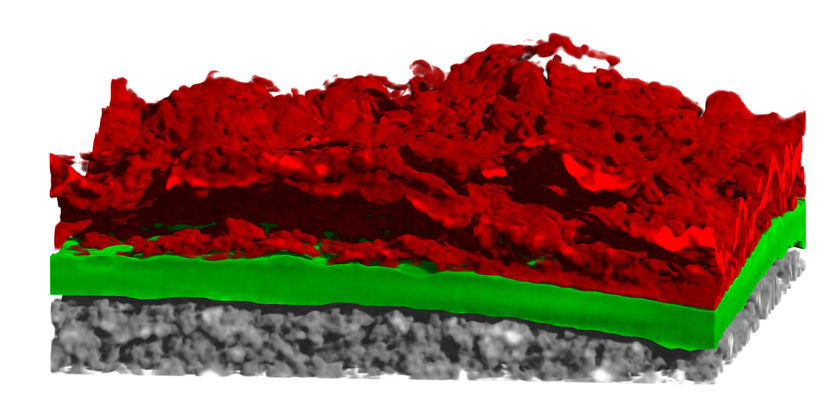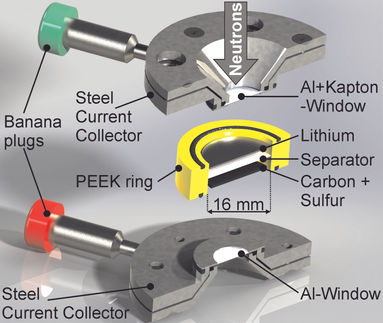3D tomographic imagery reveals how lithium batteries age
lithium batteries lose amp-hour capacity over time. Microstructures can form on the electrodes with each new charge cycle, which further reduces battery capacity. Now an HZB team together with battery researchers from Forschungszentrum Jülich, the University of Munster, and partners in China have documented the degradation process of lithium electrodes in detail for the first time. They achieved this with the aid of a 3D tomography process using synchrotron radiation at BESSY II (HZB) as well at the Helmholtz-Zentrum Geesthacht (HZG).

After a longer period of operation, areas form that reduce performance and can cause short-circuits.
M. Osenberg / I. Manke / HZB
Whether electric mobility, robotics, or IT - lithium batteries are simply used everywhere. Despite decades of improvements, it has not yet been possible to prevent such batteries from "ageing". Amp-hour capacity is lost with every charge cycle. The processes that lead to this are roughly understood. Now an international team headed by HZB researcher Dr. Ingo Manke has been able to observe with microscopic precision exactly what happens inside the battery at the interfaces between the electrodes during migration of the lithium ions.
3D insights into lithium cells
Manke is an expert in 3D synchrotron tomography, a method that utilises particularly intense X-rays. 3D images can be created of the interior of samples using this non-destructive imaging method with particularly high precision that is available on the BAM beamline at BESSY II. His team investigated a number of different lithium cells during charging and discharging under different cycle conditions. All cells studied had one side of the electrode made of pure lithium, while the other side was constructed of a selection of different electrode materials. Part of the investigation also took place at the Helmholtz-Zentrum Geesthacht.
Formation of microstructures
The tomographic imagery shows how a layer forms between the separator layer and the lithium electrode characterised by microscopic features after only a few charge/discharge cycles. The microscopic features of this layer consist of reaction compounds that form in the electrolyte and can take different forms – from a rather disordered slurry, to moss-like structures, to needle-shaped dendrites that can even cause dangerous short circuits in the battery.
“This gives us for the first time a complete picture of the degradation mechanism in lithium electrodes”, says Manke. It is not only of interest for fundamental understanding of the aging processes in batteries, but also provides valuable directions in the design of more durable batteries.
Original publication
Fu Sun, Xin He, Xiaoyu Jiang, Markus Osenberg, Jie Li, Dong Zhou, Kang Dong, André Hilger, Xiaoming Zhu, Rui Gao, Xiangfeng Liu, Kai Huang, De Ning, Henning Markötter, Li Zhang, Fabian Wilde, Yuliang Cao, Martin Winter, Ingo Manke; "Advancing knowledge of electrochemically generated lithium microstructure and performance decay of lithium ion battery by synchrotron X-ray tomography"; Materials Today; 2018
Most read news
Original publication
Fu Sun, Xin He, Xiaoyu Jiang, Markus Osenberg, Jie Li, Dong Zhou, Kang Dong, André Hilger, Xiaoming Zhu, Rui Gao, Xiangfeng Liu, Kai Huang, De Ning, Henning Markötter, Li Zhang, Fabian Wilde, Yuliang Cao, Martin Winter, Ingo Manke; "Advancing knowledge of electrochemically generated lithium microstructure and performance decay of lithium ion battery by synchrotron X-ray tomography"; Materials Today; 2018
Organizations
Other news from the department science

Get the analytics and lab tech industry in your inbox
By submitting this form you agree that LUMITOS AG will send you the newsletter(s) selected above by email. Your data will not be passed on to third parties. Your data will be stored and processed in accordance with our data protection regulations. LUMITOS may contact you by email for the purpose of advertising or market and opinion surveys. You can revoke your consent at any time without giving reasons to LUMITOS AG, Ernst-Augustin-Str. 2, 12489 Berlin, Germany or by e-mail at revoke@lumitos.com with effect for the future. In addition, each email contains a link to unsubscribe from the corresponding newsletter.



















































